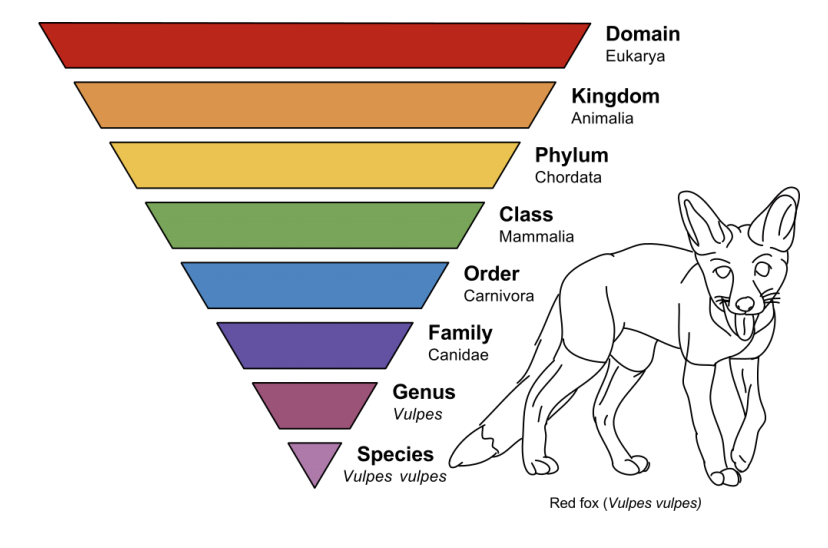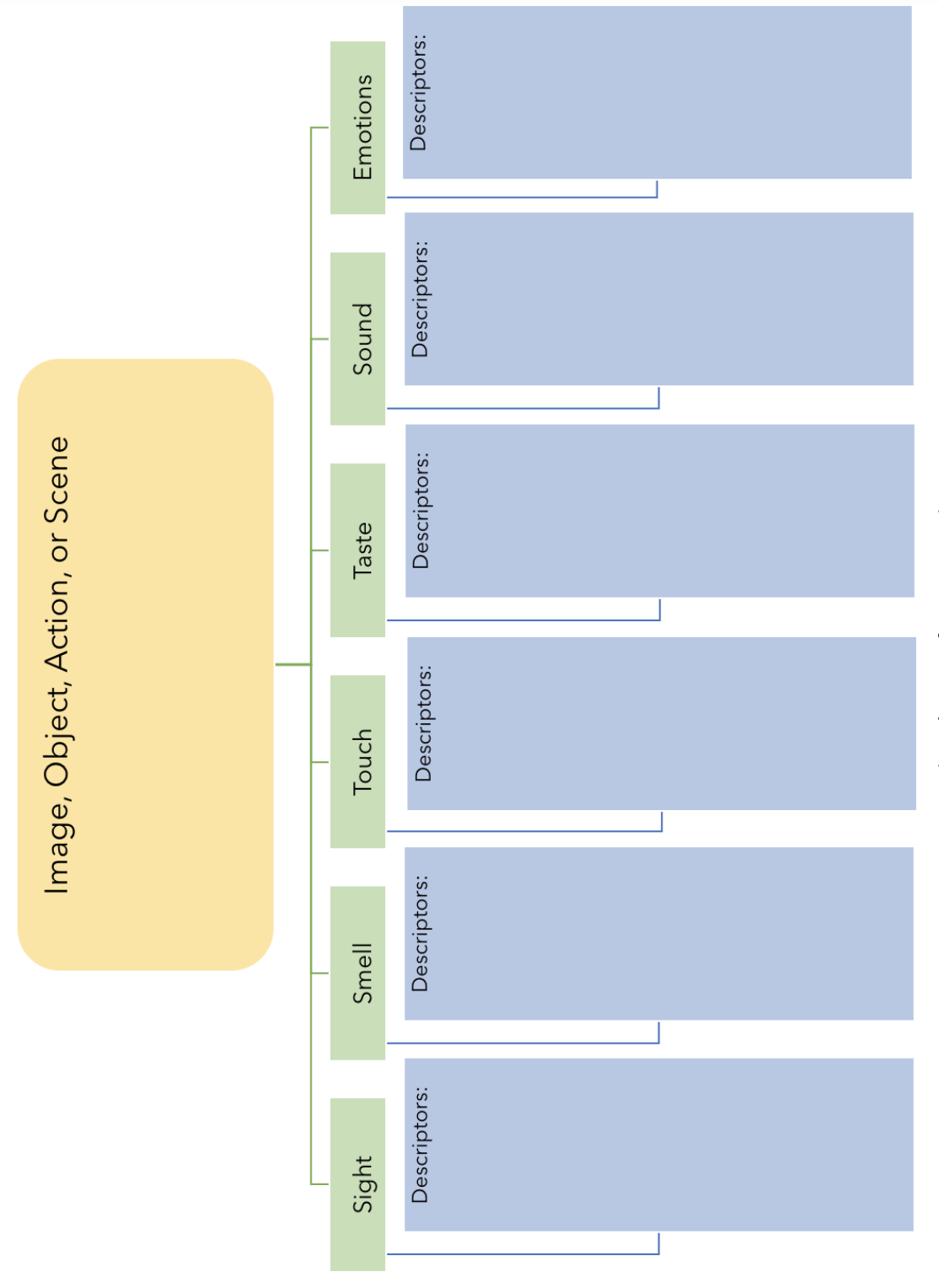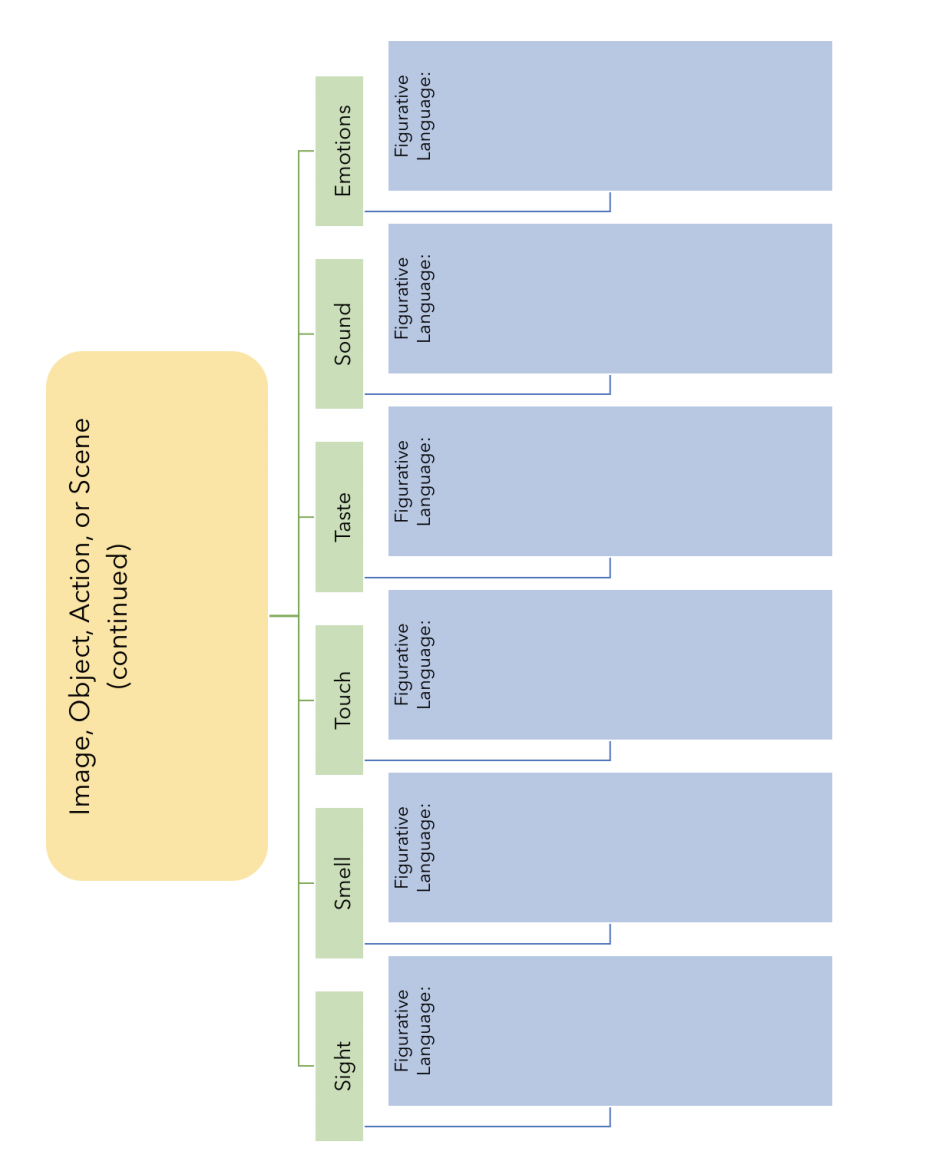1.1.3: Activites
- Page ID
- 70728
Activities
Specificity Taxonomy
Good description lives and dies in particularities. It takes deliberate effort to refine our general ideas and memories into more focused, specific language that the reader can identify with.
A taxonomy is a system of classification that arranges a variety of items into an order that makes sense to someone. You might remember from your biology class the ranking taxonomy based on Carl Linnaeus’ classifications, pictured here.

"Taxonomic Rank Graph" by Annina Breen is licensed under CC BY_SA 4.0
To practice shifting from general to specific, fill in the blanks in the taxonomy21 below. After you have filled in the blanks, use the bottom three rows to make your own. As you work, notice how attention to detail, even on the scale of an individual word, builds a more tangible image.
Exercise 1
| (example): | More General | General | Specific | More Specific |
| animal | mammal | dog | Great Dane | |
| 1 | organism | conifer | Douglas fir | |
| airplane | Boeing 757 | |||
| 2 | novel | Harry Potter and the Goblet of Fire | ||
| clothing | blue jeans | |||
| 3 | medical condition | respiratory infection | the common cold | |
| school | college | |||
| 4 | artist | pop singer | ||
| structure | building | The White House | ||
| 5 | coffee | Starbucks coffee | ||
| scientist | Sir Isaac Newton | |||
| 6 | ||||
Compare your answers with a classmate. What similarities do you share with other students? What differences? Why do you think this is the case? How can you apply this thinking to your own writing?
Micro-Ethnography
An ethnography is a form of writing that uses thick description to explore a place and its associated culture. By attempting this method on a small scale, you can practice specific, focused description.
Find a place in which you can observe the people and setting without actively involving yourself. (Interesting spaces and cultures students have used before include a poetry slam, a local bar, a dog park, and a nursing home.) You can choose a place you’ve been before or a place you’ve never been: the point here is to look at a space and a group of people more critically for the sake of detail, whether or not you already know that context.
As an ethnographer, your goal is to take in details without influencing those details. In order to stay focused, go to this place alone and refrain from using your phone or doing anything besides note-taking. Keep your attention on the people and the place.
- Spend a few minutes taking notes on your general impressions of the place at this time.
- Use imagery and thick description to describe the place itself. What sorts of interactions do you observe? What sort of tone, affect, and language is used? How would you describe the overall atmosphere?
- Spend a few minutes “zooming in” to identify artifacts—specific physical objects being used by the people you see.
- Use imagery and thick description to describe the specific artifacts. How do these parts contribute to/differentiate from/relate to the whole of the scene?
After observing, write one to two paragraphs synthesizing your observations to describe the space and culture. What do the details represent or reveal about the place and people?
Imagery Inventory
Visit a location you visit often—your classroom, your favorite café, the commuter train, etc. Isolate each of your senses and describe the sensations as thoroughly as possible. Take detailed notes in the organizer below, or use a voice-recording app on your phone to talk through each of your sensations.
Exercise 2
| Sense | Sensation |
|---|---|
| Sight | |
| Sound | |
| Smell | |
| Touch | |
| Taste |
Now, write a paragraph that synthesizes three or more of your sensory details. Which details were easiest to identify? Which make for the most striking descriptive language? Which will bring the most vivid sensations to your reader’s mind?
The Dwayne Johnson Activity
This exercise will encourage you to flex your creative descriptor muscles by generating unanticipated language.
Begin by finding a mundane object. (A plain, unspectacular rock is my go-to choice.) Divide a blank piece of paper into four quadrants. Set a timer for two minutes; in this time, write as many describing words as possible in the first quadrant. You may use a bulleted list. Full sentences are not required.

"Stones" by Carol Von Canon is licensed under CC BY-ND 2.0
Now, cross out your first quadrant. In the second quadrant, take five minutes to write as many new describing words as possible without repeating anything from your first quadrant. If you’re struggling, try to use imagery and/or figurative language.
For the third quadrant, set the timer for two minutes. Write as many uses as possible for your object.
Before starting the fourth quadrant, cross out the uses you came up with for the previous step. Over the next five minutes, come up with as many new uses as you can.
After this generative process, identify your three favorite items from the sections you didn’t cross out. Spend ten minutes writing in any genre or form you like—a story, a poem, a song, a letter, anything—on any topic you like. Your writing doesn’t have to be about the object you chose, but try to incorporate your chosen descriptors or uses in some way.
Share your writing with a friend or peer, and debrief about the exercise. What surprises did this process yield? What does it teach us about innovative language use?22

Surprising Yourself: Constraint-Based Scene Description
This exercise23 asks you to write a scene, following specific instructions, about a place of your choice. There is no such thing as a step-by-step guide to descriptive writing; instead, the detailed instructions that follow are challenges that will force you to think differently while you’re writing. The constraints of the directions may help you to discover new aspects of this topic since you are following the sentence-level prompts even as you develop your content.
1) Bring your place to mind. Focus on “seeing” or “feeling” your place.
2) For a title, choose an emotion or a color that represents this place to you.
3) For a first line starter, choose one of the following and complete the sentence:
You stand there..., Every time..., We had been..., When I'm here, I know that..., I [see/smell/hear/feel/taste]..., I think sometimes...
4) After your first sentence, create your scene, writing the sentences according to the following directions:
Sentence 2: Write a sentence with a color in it.
Sentence 3: Write a sentence with a part of the body in it.
Sentence 4: Write a sentence with a simile (a comparison using like or as)
Sentence 5: Write a sentence of over twenty-five words.
Sentence 6: Write a sentence of under eight words.
Sentence 7: Write a sentence with a piece of clothing in it.
Sentence 8: Write a sentence with a wish in it.
Sentence 9: Write a sentence with an animal in it.
Sentence 10: Write a sentence in which three or more words alliterate; that is, they begin with the same initial consonant: “She has been left, lately, with less and less time to think….”
Sentence 11: Write a sentence with two commas.
Sentence 12: Write a sentence with a smell and a color in it.
Sentence 13: Write a sentence without using the letter “e.”
Sentence 14: Write a sentence with a simile.
Sentence 15: Write a sentence that could carry an exclamation point (but don’t use the exclamation point).
Sentence 16: Write a sentence to end this portrait that uses the word or words you chose for a title.
5) Read over your scene and mark words/phrases that surprised you, especially those rich with possibilities (themes, ironies, etc.) that you could develop.
6) On the right side of the page, for each word/passage you marked, interpret the symbols, name the themes that your description and detail suggest, note any significant meaning you see in your description.
7) On a separate sheet of paper, rewrite the scene you have created as a more thorough and cohesive piece in whatever genre you desire. You may add sentences and transitional words/phrases to help the piece flow.
Image Builder
This exercise encourages you to experiment with thick description by focusing on one element of your writing in expansive detail. Read the directions below, then use the graphic organizer on the following two pages or write your responses as an outline on a separate piece of paper.
1. Identify one image, object, action, or scene that you want to expand in your story. Name this element in the big, yellow bubble.
2. Develop at least three describing words for your element, considering each sense independently, as well as emotional associations. Focus on particularities. (Adjectives will come most easily, but remember that you can use any part of speech.)
3. Then, on the next page, create at least two descriptions using figurative language (metaphor, simile, personification, onomatopoeia, hyperbole, etc.) for your element, considering each sense independently, as well as emotional associations. Focus on particularities.
4. Finally, reflect on the different ideas you came up with.
a. Which descriptions surprised you? Which descriptions are accurate but unanticipated?
b. Where might you weave these descriptions in to your current project?
c. How will you balance description with other rhetorical modes, like narration, argumentation, or analysis?
5. Repeat this exercise as desired or as instructed, choosing a different focus element to begin with.
6. Choose your favorite descriptors and incorporate them into your writing.
If you’re struggling to get started, check out the example on the pages following the blank organizer.
Example \(\{1}\)


- Solution
-



